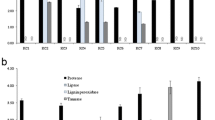Abstract
Cellulolytic activity can be released from rumen Entodiniomorphid protozoa by gentle sonication (Coleman, 1978) and there is evidence that most of this activity is of protozoal rather than bacterial origin (Coleman, 1978). Cellulolytic activity can also be released under the same conditions from a crude mixture of bacteria isolated from the rumen. The purpose of this communication is to compare the cellulolytic activity in fractions (prepared by sonication followed by centrifugation (15,500g, 30 min) to produce a clear, bacteria-free supernatant fluid) from faunated and defaunated sheep.
Activities were measured by the release of reducing material from carboxymethylcellulose and the release of dye from cellulose azure (Sigma, type II), but unfortunately with both methods the relationship between product and time or enzyme concentration was a curve with a steadily decreasing slope. To overcome this difficulty a standard curve of product against concentration of an extract of the ciliateEpidinium ecaudatum caudatum was constructed for all experiments. Using this curve, the amount of product formed with other enzyme preparations was converted into concentrations of this extract. The specific activity (activity/mg protein) of this extract was taken to be 100.
Fractions were prepared from strained rumen contents by differential centrifugation and after sonication and centrifugation as described above, no activity was found in the 360g min pellet (“protozoal fraction”) from defaunated sheep or in the green or brown layer that was present above the protozoa in the same fraction from refaunated animals. Cellulolytic activity was progressively released from washed rumen bacteria prepared from both types of sheep during sonication for 15 min, at which time the specific activity of the material was 2–3% of that in the protozoon. There was a small but variable amount of activity (specific activity, 0.1–1.0%) in the cell-free rumen liquor.
If it is assumed that the activity released from the protozoa and bacteria is actually available to degrade cellulose, an estimate can be made of the comparative importance of protozoa and bacteria in rumen cellulolysis. In a sheep containing 20,000 epidinia/mL as the only ciliate protozoon, the bacteria and cellfree rumen liquor contained only 12 and 2 1/2%, respectively, of the activity in the protozoa. If 65% of the protozoa die and are degraded in the rumen (Leng, 1982), then the protozoal cellulase released could be very important in cellulose degradation.
Similar content being viewed by others
References
Coleman, G. S. (1978),J. Gen. Microbiol. 107, 359.
Leng, R. A. (1982),Brit. J. Nutr. 48, 399.
Author information
Authors and Affiliations
Rights and permissions
About this article
Cite this article
Coleman, G.S. A comparison of the cellulolytic activities of rumen bacteria and protozoa. Appl Biochem Biotechnol 9, 347–348 (1984). https://doi.org/10.1007/BF02798969
Issue Date:
DOI: https://doi.org/10.1007/BF02798969




